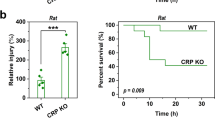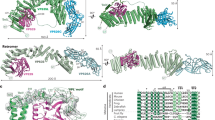Abstract
The maturation of human RET is adversely affected by a range of missense mutations found in patients with Hirschsprung's disease (HSCR), a complex multigenic disease. Here we show that two N-terminal cadherin-like domains, CLD1 and CLD2 (CLD(1-2)), from human RET adopt a clam-shell arrangement distinct from that of classical cadherins. CLD1 structural elements and disulfide composition are unique to mammals, indicating an unexpected structural diversity within higher and lower vertebrate RET CLD regions. We identify two unpaired cysteines that predispose human RET to maturation impediments in the endoplasmic reticulum and establish a quantitative cell-based RET maturation assay that offers a biochemical correlate of HSCR disease severity. Our findings provide a key conceptual framework and means of testing and predicting genotype-phenotype correlations in HSCR.
This is a preview of subscription content, access via your institution
Access options
Subscribe to this journal
Receive 12 print issues and online access
$189.00 per year
only $15.75 per issue
Buy this article
- Purchase on Springer Link
- Instant access to full article PDF
Prices may be subject to local taxes which are calculated during checkout




Similar content being viewed by others
References
Schuchardt, A., D'Agati, V., Larsson-Blomberg, L., Costantini, F. & Pachnis, V. Defects in the kidney and enteric nervous system of mice lacking the tyrosine kinase receptor Ret. Nature 367, 380–383 (1994).
Veiga-Fernandes, H. et al. Tyrosine kinase receptor RET is a key regulator of Peyer's patch organogenesis. Nature 446, 547–551 (2007).
Edery, P. et al. Mutations of the RET proto-oncogene in Hirschsprung's disease. Nature 367, 378–380 (1994).
Skinner, M.A., Safford, S.D., Reeves, J.G., Jackson, M.E. & Freemerman, A.J. Renal aplasia in humans is associated with RET mutations. Am. J. Hum. Genet. 82, 344–351 (2008).
Parkash, V. et al. The structure of the glial cell line-derived neurotrophic factor-coreceptor complex: insights into RET signalling and heparin binding. J. Biol. Chem. 283, 35164–35172 (2008).
Wang, X., Baloh, R.H., Milbrandt, J. & Garcia, K.C. Structure of artemin complexed with its receptor GFRα3: convergent recognition of glial cell line-derived neurotrophic factors. Structure 14, 1083–1092 (2006).
Treanor, J.J. et al. Characterization of a multicomponent receptor for GDNF. Nature 382, 80–83 (1996).
Anders, J., Kjær, S. & Ibáñez, C.F. Molecular modeling of the extracellular domain of the RET receptor tyrosine kinase reveals multiple cadherin-like domains and a calcium-binding site. J. Biol. Chem. 276, 35808–35817 (2001).
Kjær, S. & Ibáñez, C.F. Identification of a surface for binding to the GDNF-GFRα1 complex in the first cadherin-like domain of RET. J. Biol. Chem. 278, 47898–47904 (2003).
de Graaff, E. et al. Differential activities of the RET tyrosine kinase receptor isoforms during mammalian embryogenesis. Genes Dev. 15, 2433–2444 (2001).
Abrescia, C., Sjostrand, D., Kjær, S. & Ibáñez, C.F. Drosophila RET contains an active tyrosine kinase and elicits neurotrophic activities in mammalian cells. FEBS Lett. 579, 3789–3796 (2005).
Hahn, M. & Bishop, J. Expression pattern of Drosophila ret suggests a common ancestral origin between the metamorphosis precursors in insect endoderm and the vertebrate enteric neurons. Proc. Natl. Acad. Sci. USA 98, 1053–1058 (2001).
Kashuk, C.S. et al. Phenotype-genotype correlation in Hirschsprung disease is illuminated by comparative analysis of the RET protein sequence. Proc. Natl. Acad. Sci. USA 102, 8949–8954 (2005).
Kjær, S. & Ibáñez, C.F. Intrinsic susceptibility to misfolding of a hot-spot for Hirschsprung disease mutations in the ectodomain of RET. Hum. Mol. Genet. 12, 2133–2144 (2003).
Hirsch, C., Gauss, R., Horn, S.C., Neuber, O. & Sommer, T. The ubiquitylation machinery of the endoplasmic reticulum. Nature 458, 453–460 (2009).
Heanue, T.A. & Pachnis, V. Enteric nervous system development and Hirschsprung's disease: advances in genetic and stem cell studies. Nat. Rev. Neurosci. 8, 466–479 (2007).
Boggon, T.J. et al. C-cadherin ectodomain structure and implications for cell adhesion mechanisms. Science 296, 1308–1313 (2002).
Patel, S.D. et al. Type II cadherin ectodomain structures: implications for classical cadherin specificity. Cell 124, 1255–1268 (2006).
Ciatto, C. et al. T-cadherin structures reveal a novel adhesive binding mechanism. Nat. Struct. Mol. Biol. 17, 339–347 (2010).
Dames, S.A. et al. Insights into the low adhesive capacity of human T-cadherin from the NMR structure of Its N-terminal extracellular domain. J. Biol. Chem. 283, 23485–23495 (2008).
Shapiro, L., Kwong, P.D., Fannon, A.M., Colman, D.R. & Hendrickson, W.A. Considerations on the folding topology and evolutionary origin of cadherin domains. Proc. Natl. Acad. Sci. USA 92, 6793–6797 (1995).
Thornton, J.M. Disulphide bridges in globular proteins. J. Mol. Biol. 151, 261–287 (1981).
Pednekar, D., Tendulkar, A. & Durani, S. Electrostatics-defying interaction between arginine termini as a thermodynamic driving force in protein-protein interaction. Proteins 74, 155–163 (2009).
Hebert, D.N. & Molinari, M. In and out of the ER: protein folding, quality control, degradation, and related human diseases. Physiol. Rev. 87, 1377–1408 (2007).
Wang, X. et al. Hsp90 cochaperone Aha1 downregulation rescues misfolding of CFTR in cystic fibrosis. Cell 127, 803–815 (2006).
Jansens, A., van Duijn, E. & Braakman, I. Coordinated nonvectorial folding in a newly synthesized multidomain protein. Science 298, 2401–2403 (2002).
Molinari, M. N-glycan structure dictates extension of protein folding or onset of disposal. Nat. Chem. Biol. 3, 313–320 (2007).
Nollet, F., Kools, P. & van Roy, F. Phylogenetic analysis of the cadherin superfamily allows identification of six major subfamilies besides several solitary members. J. Mol. Biol. 299, 551–572 (2000).
Meier, S. et al. Continuous molecular evolution of protein-domain structures by single amino acid changes. Curr. Biol. 17, 173–178 (2007).
Amiel, J. et al. Hirschsprung disease, associated syndromes and genetics: a review. J. Med. Genet. 45, 1–14 (2008).
Cosma, M.P., Cardone, M., Carlomagno, F. & Colantuoni, V. Mutations in the extracellular domain cause RET loss of function by a dominant negative mechanism. Mol. Cell. Biol. 18, 3321–3329 (1998).
Leslie, A.G. The integration of macromolecular diffraction data. Acta Crystallogr. D Biol. Crystallogr. 62, 48–57 (2006).
Evans, P. Scaling and assessment of data quality. Acta Crystallogr. D Biol. Crystallogr. 62, 72–82 (2006).
Schneider, T.R. & Sheldrick, G.M. Substructure solution with SHELXD. Acta Crystallogr. D Biol. Crystallogr. 58, 1772–1779 (2002).
Vonrhein, C., Blanc, E., Roversi, P. & Bricogne, G. Automated structure solution with autoSHARP. Methods Mol. Biol. 364, 215–230 (2007).
Morris, R.J., Perrakis, A. & Lamzin, V.S. ARP/wARP and automatic interpretation of protein electron density maps. Methods Enzymol. 374, 229–244 (2003).
Emsley, P. & Cowtan, K. Coot: model-building tools for molecular graphics. Acta Crystallogr. D Biol. Crystallogr. 60, 2126–2132 (2004).
Murshudov, G.N., Vagin, A.A. & Dodson, E.J. Refinement of macromolecular structures by the maximum-likelihood method. Acta Crystallogr. D Biol. Crystallogr. 53, 240–255 (1997).
Salvatore, G. et al. Generation and characterization of novel monoclonal antibodies to the Ret receptor tyrosine kinase. Biochem. Biophys. Res. Commun. 294, 813–817 (2002).
Acknowledgements
We thank C.F. Ibáñez (Karolinska Institute) for encouragement, support and the RET51 cDNA, A. Purkiss-Trew for help with phasing, S. Mouilleron for help with data collection, J. Murray-Rust for help with RET modeling, M. Santoro (Univ. of Naples) for the kind gift of mAb 1D9, J. Garcia-Fernandez (Univ. of Barcelona) for the unpublished amphioxus RET sequence, the LRI Peptide Synthesis Laboratory for the disulfide-linked xRET(1-2) peptide, the European Synchrotron Radiation Facility beamline staff on ID29 and Amgen for supplies of recombinant GDNF, in particular J. Treanor. This work was supported by funding from Cancer Research UK, the EU FP6 # LSHB-CT-2004-503467 Prokinase Network and a Marie Curie Intra-European Fellowship (#010656) to S.K.
Author information
Authors and Affiliations
Contributions
S.K. performed the experiments, with the exception of the MS analysis, which was performed by S.H. and N.T.; N.Q.M. and S.K. designed the study, interpreted the results and wrote the paper.
Corresponding author
Ethics declarations
Competing interests
The authors declare no competing financial interests.
Supplementary information
Supplementary Text and Figures
Supplementary Figures 1–7, Supplementary Discussion and Supplementary Methods (PDF 1675 kb)
Rights and permissions
About this article
Cite this article
Kjær, S., Hanrahan, S., Totty, N. et al. Mammal-restricted elements predispose human RET to folding impairment by HSCR mutations. Nat Struct Mol Biol 17, 726–731 (2010). https://doi.org/10.1038/nsmb.1808
Received:
Accepted:
Published:
Issue Date:
DOI: https://doi.org/10.1038/nsmb.1808
This article is cited by
-
MiR-195-5p inhibits proliferation and invasion of nerve cells in Hirschsprung disease by targeting GFRA4
Molecular and Cellular Biochemistry (2021)
-
Whole-exome sequencing identifies mutations of TBC1D1 encoding a Rab-GTPase-activating protein in patients with congenital anomalies of the kidneys and urinary tract (CAKUT)
Human Genetics (2016)
-
RET revisited: expanding the oncogenic portfolio
Nature Reviews Cancer (2014)
-
Male and female differential reproductive rate could explain parental transmission asymmetry of mutation origin in Hirschsprung disease
European Journal of Human Genetics (2012)
-
Mutations in the NRG1 gene are associated with Hirschsprung disease
Human Genetics (2012)



